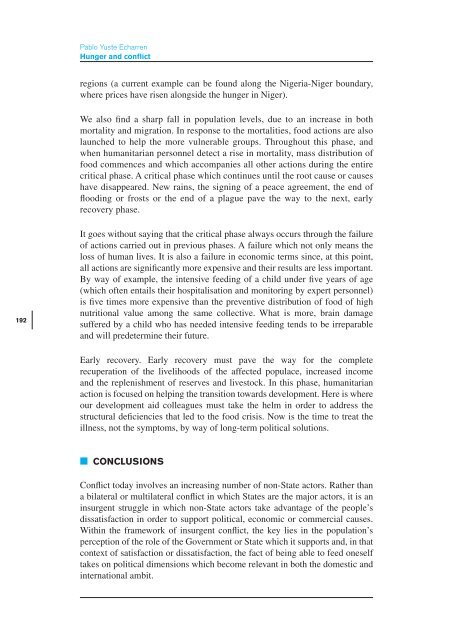Food security and global security - IEEE
Food security and global security - IEEE
Food security and global security - IEEE
- No tags were found...
You also want an ePaper? Increase the reach of your titles
YUMPU automatically turns print PDFs into web optimized ePapers that Google loves.
Pablo Yuste EcharrenHunger <strong>and</strong> conflictregions (a current example can be found along the Nigeria-Niger boundary,where prices have risen alongside the hunger in Niger).We also find a sharp fall in population levels, due to an increase in bothmortality <strong>and</strong> migration. In response to the mortalities, food actions are alsolaunched to help the more vulnerable groups. Throughout this phase, <strong>and</strong>when humanitarian personnel detect a rise in mortality, mass distribution offood commences <strong>and</strong> which accompanies all other actions during the entirecritical phase. A critical phase which continues until the root cause or causeshave disappeared. New rains, the signing of a peace agreement, the end offlooding or frosts or the end of a plague pave the way to the next, earlyrecovery phase.192It goes without saying that the critical phase always occurs through the failureof actions carried out in previous phases. A failure which not only means theloss of human lives. It is also a failure in economic terms since, at this point,all actions are significantly more expensive <strong>and</strong> their results are less important.By way of example, the intensive feeding of a child under five years of age(which often entails their hospitalisation <strong>and</strong> monitoring by expert personnel)is five times more expensive than the preventive distribution of food of highnutritional value among the same collective. What is more, brain damagesuffered by a child who has needed intensive feeding tends to be irreparable<strong>and</strong> will predetermine their future.Early recovery. Early recovery must pave the way for the completerecuperation of the livelihoods of the affected populace, increased income<strong>and</strong> the replenishment of reserves <strong>and</strong> livestock. In this phase, humanitarianaction is focused on helping the transition towards development. Here is whereour development aid colleagues must take the helm in order to address thestructural deficiencies that led to the food crisis. Now is the time to treat theillness, not the symptoms, by way of long-term political solutions.■■CONCLUSIONSConflict today involves an increasing number of non-State actors. Rather thana bilateral or multilateral conflict in which States are the major actors, it is aninsurgent struggle in which non-State actors take advantage of the people’sdissatisfaction in order to support political, economic or commercial causes.Within the framework of insurgent conflict, the key lies in the population’sperception of the role of the Government or State which it supports <strong>and</strong>, in thatcontext of satisfaction or dissatisfaction, the fact of being able to feed oneselftakes on political dimensions which become relevant in both the domestic <strong>and</strong>international ambit.
















